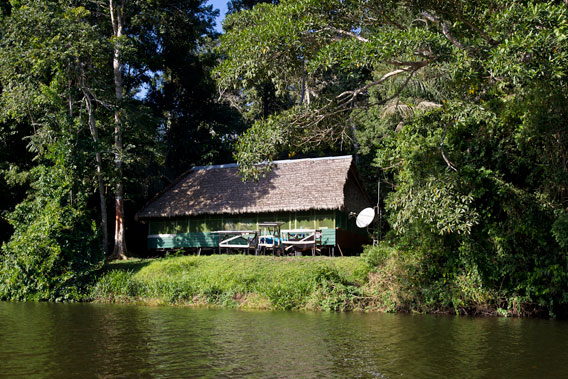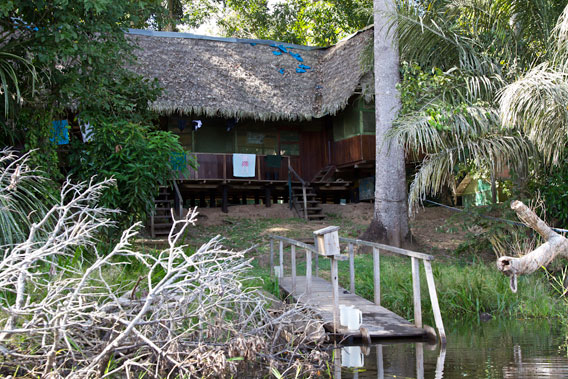
Cocha Cashu lab as viewed from lake. Photo by: Ken Bohn of San Diego Zoo Global.
The San Diego Zoo Global Wildlife Conservancy is taking over management of the productive Cocha Cashu field station in Manu National Park, Peru. To date, nearly 600 scientific papers have come out of research conducted at the station, making it among the five most productive research stations in the Amazon and Andes. Located in a part of the Amazon rainforest that has seen little human impact, the station was founded in 1969, four years before Manu National Park was gazetted.
“I remember my first visit to Cocha Cashu clearly. And I knew of the Stationís reputation long before that. So when I finally walked the half kilometer from the Manu River to the field site I did so with mixed feelings of awe and curiosity,” Jessica Groenendijk, Cocha Cashu’s Education and Outreach Coordinator for the San Diego Zoo Institute for Conservation Research, told mongabay.com. “I was about to meet a bunch of top tropical ecology researchers in a location which is renowned for its ground-breaking science; would I feel out of place? I need not have worried. As I neared the end of the winding, root-strewn trail, I was greeted by someone washing her clothes in a sun-lit clearing. In front of me were two small buildings with thatched roofs. One was filled with laughing people (I had arrived at lunch time), the other I later learned was known as the bath house. I was invited for a cup of coffee, and found myself face to face with John Terborgh, director of the Center of Tropical Conservation and a professor at Duke University.”
Groenendijk says John Terborgh has been instrumental to Cocha Cashu’s success as a field station, including supporting Peruvian students, 21 of whom conducted PhD research at the station.
“Over four decades, John turned a small station, built jointly by the La Molina National Agrarian University and the Frankfurt Zoological Society, into a giant: ‘giant’ not in terms of size, but in terms of its contribution to knowledge and conservation of tropical ecology,” she says.
At the beginning of the year, the San Diego Zoo Global Wildlife Conservancy signed an agreement with SERNANP, Peru’s Protected Areas Service, to manage the facility.
“Together with SERNANP, we intend to build on the reputation of Cocha Cashu as a premier field research site and training facility for conservation scientists, while maintaining its uniquely simple flavor,” says Groenendijk. “Immediate priorities for the station are to establish a reliable power supply, and a more efficient internet, radio, and phone communication with the outside world. We will upgrade infrastructure, including new toilets and showers. Logistics and transportation to and from the site will also be improved with the purchase of another boat and two 4-stroke engines. We are actively recruiting students and scientists to come to the station, in the hope of maximizing its potential. And, in the longer term, we will initiate a capacity-building training course for Park guards and administrators, involve local school children and communities in conservation education initiatives, and develop our own research program.”
The San Diego Zoo Global Wildlife Conservancy currently runs a number of additional field stations, including ones in Cameroon, Mexico, Hawaii, Nevada, and San Clemente Island.
Of all the reasons to do research at Cocha Cashu, the stand-out is the rich wildlife of what is often debated as the most biodiverse place in the world.
“It is a place of superlatives: the world record for the number of bird species seen in a single day (14 hours to be exact), without the help of motorized vehicles, was established here by Ted Parker and Scott Robinson in 1982 and is yet to be surpassed ñ they recorded a mind boggling 331 different bird species. Others have discovered a similar diversity amongst the fish, amphibians, mammals, and plants of the area.”
Groenendijk says that despite having such a presence in tropical forest research, the Cocha Cashu field station has not lost sight of its roots.
“When I visited Cocha Cashu again recently, I found it had not changed one iota since that first visit of mine in 1999. It has retained its rustic, informal charm, the low thatched buildings, the friendly atmosphere, the pizza night tradition. The giant otters are still on the lake and pass by the lab every day. Researchers still sleep in tents in the forest and are woken by the epic roars of howler monkeys early in the morning. Here, you not only study nature, you are surrounded by it at all times, you live and breathe nature. Very few people who stay at Cashu leave without feelings of regret. Many, even decades later, long to return. Cocha Cashu is a very special place and we intend to keep it that way.”

Cocha Cashu bath house. Photo by: Ken Bohn of San Diego Zoo Global.
Related articles
Thousands protest giant gold mine in Peru’s mountains
(11/29/2011) Fearing water contamination and pollution, over ten thousand people in Cajamarca, Peru are taking part in protests against mining plans by US-company Newmont Mining Corporation. In its sixth day, the growing protests have caused flights in and out of Cajamarca to be cancelled. According to Reuters, police also clashed with protestors today, injuring two dozen.
8 Amazon countries pledge more coordination in rainforest conservation
(11/27/2011) Eight Amazon countries pledged greater cooperation in efforts to protect the world’s largest rainforest from deforestation and illegal mining and logging, reports AFP.
Ecotourism isn’t bad for wildlife in the Amazon
(11/23/2011) Ecotourism doesn’t hurt biodiversity, and in some cases may even safeguard vulnerable areas, concludes a new study from the Amazon in Mammalian Biology. Surveying large mammals in an ecotourism area in Manu National Biosphere, the researchers found that ecotourists had no effect on the animals. However, the researchers warn that not all ecotourism is the same, and some types may, in fact, hurt the very animals tourists come to see.







